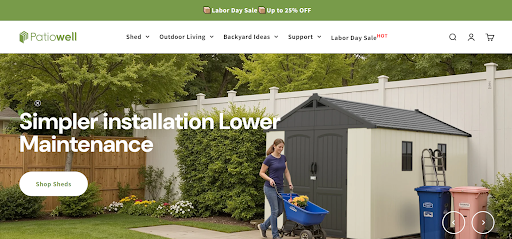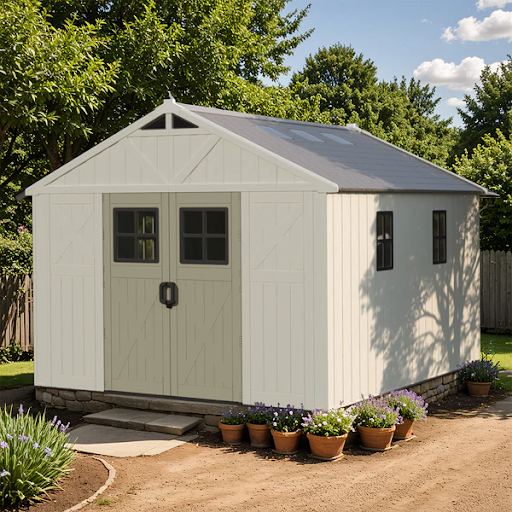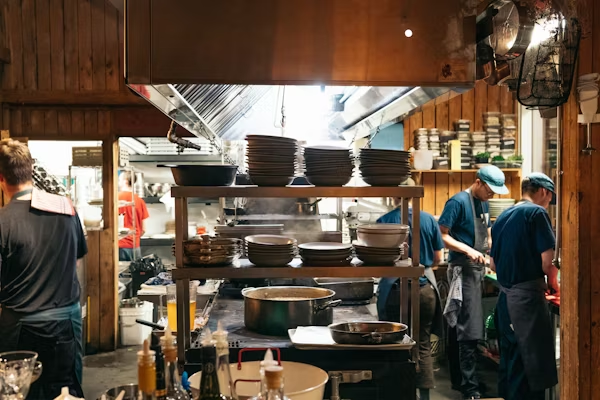Home Improvement
Best Outdoor Storage Sheds: Lifetime vs. Suncast vs. Patiowell

Choosing the right outdoor storage shed can be overwhelming. With so many brands offering different features, sizes, and materials, homeowners often struggle to decide which shed best meets their needs. Among the top contenders in the outdoor storage space are Lifetime, Suncast, and Patiowell. Each brand brings unique strengths to the table, but if you’re looking for a balance of durability, design, and affordability, Patiowell stands out as a compelling choice.
In this article, we’ll compare these three popular shed brands and explore why Patiowell deserves your attention.
Lifetime Sheds: Reliable but Bulky
Lifetime is well-known for its heavy-duty polyethylene sheds. These sheds are designed to withstand extreme weather conditions and often include steel reinforcement for extra durability. They’re great for those who want something that will last for years without worrying about frequent maintenance.
Pros
- Sturdy, all-weather polyethylene material
- UV-protected to prevent fading
- Spacious interior options
Cons
- Installation can be complicated and time-consuming
- Designs are somewhat basic and utilitarian
- Higher price point compared to other resin shed options
Suncast Sheds: Stylish but Limited in Size
Suncast sheds have gained popularity for their sleek designs and ease of assembly. These sheds are often smaller in size, making them ideal for garden tools, patio cushions, and seasonal storage.
Pros
- Attractive designs that complement outdoor décor
- Easy-to-assemble panels
- Affordable entry-level models
Cons
- Less durable in extreme climates
- Smaller storage capacity compared to competitors
- Limited customization options
Patiowell Sheds: Durability Meets Modern Design
A newer name in the outdoor storage shed industry, Patiowell has quickly become a trusted brand for homeowners who want functionality without sacrificing style. Their sheds are built from high-quality resin, offering the same weather resistance as Lifetime while maintaining the sleek aesthetics often associated with Suncast.

The Patiowell resin shed lineup is particularly impressive, combining reinforced panels with easy assembly. They are resistant to rust, rot, and UV damage, ensuring they stay looking new for years. Whether you need a compact shed for garden supplies or a spacious unit for bikes, tools, and patio furniture, Patiowell offers versatile sizing options.
Pros
- Durable resin construction with reinforced walls
- Modern designs that blend with backyard aesthetics
- Easy-to-follow assembly instructions
- Competitive pricing without compromising quality
Cons
- As a relatively new brand, it has fewer models than its larger competitors
- Availability may vary depending on the region
For those looking to purchase directly, the Patiowell store at patiowell.com provides a wide selection of sheds, along with detailed product descriptions and support resources.
Which Shed Should You Choose?
- Choose Lifetime if you want a heavy-duty shed that can withstand extreme weather and don’t mind a bulkier design.
- Choose Suncast if you prefer a stylish, smaller shed for light storage needs.
- Choose Patiowell if you want the best of both worlds—durability, attractive design, and affordability.
Final Thoughts
When comparing Lifetime, Suncast, and Patiowell, it’s clear that each brand caters to a different type of homeowner. If you’re seeking a long-lasting, attractive, and budget-friendly solution, Patiowell shines as a strong contender. Their Patiowell resin shed models combine modern design with reliable durability, making them a smart investment for any backyard.
For the latest collection and direct purchases, explore the Patiowell store at patiowell.com.
Home Improvement
The Top 6 Mistakes to Avoid When Buying Outside Ceiling Fans

If you want to enhance your outdoor space, installing a fan can be a smart way to boost comfort, improve air circulation, and make evenings more enjoyable. The outdoor space can be a covered porch, patio, or pergola, and adding a fan brings both function and charm into the space. When choosing a fan, it is important to know that not all fans are created equally, and choosing the wrong one can lead to frustration and waste of money.
Many people rush their decisions when thinking of buying outside ceiling fans. And they tend to miss out on details such as materials, airflow rating, and installation requirements. A fan that is designed for indoors will not be able to withstand outdoor conditions. In this article, we’ll explore the top mistakes most people make when buying a fan for outdoor use.
1. Choosing the Wrong Material
Talking about the outdoor fixtures, materials matter more than you think. Factors like moisture, temperature swings, and even salty air can damage a fan made with the wrong components. For instance, the metal parts might rust, blades can warp, and finishes may fade or peel.
Fans that are used in covered patios might need to handle only the humidity. But if it is the ones that are exposed to outer areas, they should resist direct rain. Blades that are made of ABS plastic or specially treated wood alternatives tend to last longer and hold their shape better outdoors.
2. Not Considering the Fan’s Damp or Wet Rating
Outdoor conditions are different; similarly, the ratings for ceiling fans are also different. There’s a major difference between damp-rated and wet-rated models. Overlooking those differences can lead to early damage or electrical hazards.
- Damp-rated fans work well in covered areas protected from rain.
- Wet-rated fans are built to handle direct water contact, even during heavy storms.
If you’re planning to install the fan above a pool deck, open pergola, or exposed veranda, a wet-rated design is best-suited. Damp-rated options might seem attractive, but they simply aren’t built to withstand serious moisture in outer space.
3. Not Measuring Properly
One of the most common mistakes people make while buying an outdoor fan is choosing the wrong fan size. If it is too small, it won’t move enough air, whereas if it is too large, then it can overwhelm a compact area or seem out of place. It is necessary to measure the square footage of your space before buying.
For areas that are up to 144 square feet, a 42-inch fan might be enough. Larger patios might need 52 inches or more. Also, do not miss out the ceiling height. You should have enough clearance between the blades and the floor, ideally 7 feet or higher, for safe working.
4. Ignoring the Importance of Airflow
A fan is not just a decorative fixture; it should move air effectively. Many buyers focus on the design without checking the airflow rating. This rating will usually be listed in CFM (cubic feet per minute). If the CFM is higher, then the breeze will be stronger. Outside fans should offer higher airflow than the ones that are used indoors. This is because there are not many walls in the outdoor areas, so the breeze can disperse more quickly.
5. Forgetting About the Controls
The controls of your fan can make or break your experience. Many people install a fan without even realizing that it can’t easily adjust the speed or direction. Some outdoor fans come with wall switches, others with remote controls, and a few are compatible with smart systems.
Before purchasing a fan, think about where the controls will be used. Will the place be protected from moisture? Can they reach the fan from a distance? If it is a remote control one, ensure that it’s waterproof and stored in a safe spot. Usually, outdoor wired switches are more reliable, especially in exposed areas.
6. Overlooking the Seasonal Use
Along with the other aspects, it is also essential to think about the year-round use. Some fans offer reversible blades that will push warm air downward during cooler months and vice versa. Some might have lights for evening gatherings, or also have timers to shut off automatically.
If you plan to use the space throughout the year, make sure your fan supports seasonal changes. Choosing the features that suit your lifestyle will help you buy the fan smartly. The right option can serve multiple purposes beyond warm-weather relief.
Outside ceiling fans are always a valuable addition to any outdoor living space, but buying the wrong one can lead to a waste of time, effort, and money. Paying attention to the material quality, airflow, control systems, and installation needs, you can avoid the most common mistakes most people make. A little planning goes a long way toward creating a comfortable, stylish, and lasting environment.
Home Improvement
How Property Staging Can Transform Your Home Sale Journey

Selling a home can be a challenging and emotional process. Properly showcasing a property to potential buyers requires strategy and insight. This is where property staging becomes vital. By transforming a living space into an aesthetically appealing and welcoming environment, sellers can significantly enhance the likelihood of a successful and profitable sale.
Understanding the Concept of Property Staging
Property staging is the process by which a home is furnished and decorated to make it look more attractive to potential buyers. It involves arranging furniture, accessorising rooms, and sometimes even undertaking minor renovations to highlight the best features of the property. The goal is to present the home in a way that allows the buyer to visualise themselves living in the space.
The Impact of First Impressions
First impressions are critical when selling a home. Buyers often form an opinion about a property within the first few moments of viewing it. A well-staged home can create a powerful initial impact that may linger with potential buyers, often becoming a key factor in their purchasing decision.
Increasing Home Value Through Staging
While property staging incurs some upfront costs, the return on investment can be substantial. Staged homes often sell faster and for higher prices compared to non-staged homes. The act of staging acts as an investment into the home’s potential market value.
Highlighting Spaces and Features
One of the primary objectives of property staging is to showcase the best aspects of a home. Professional stagers use colours, lighting, and layouts to emphasise spaciousness, maximise natural light, and draw attention to architectural features such as fireplaces or unique window designs.
Emphasising Versatility and Functionality
A significant benefit of property staging is the ability to demonstrate the functionality and potential uses of spaces within a home. Buyers often appreciate seeing how they can utilise various areas. For instance, a spare bedroom could be staged as a home office, appealing to those seeking a flexible living environment.
Appealing to a Broader Audience
Staging helps to neutralise personal styles and tastes, which can make a home appeal to a wider audience. By transforming the interior to something more universally appealing, sellers can attract a diverse range of potential buyers, increasing the chances of sale.
The Role of Technology in Modern Staging
In recent years, technology has become an integral part of property staging. Virtual staging, for instance, uses digital tools to allow buyers to see potential renovations or furnishings without any physical changes. This new dimension of staging offers cost-effective solutions to showcase the property’s best potential.
The Professional Touch: Hiring Stagers
Professional property stagers bring expertise and an objective eye that can transform a home into a showpiece. Their knowledge of design trends, buyer psychology, and market conditions enables them to prepare a property that appeals to the target buyer demographic.
DIY Staging Tips for Homeowners
For those preferring to stage their own home, certain principles can be applied. Decluttering, deep cleaning, and creating an inviting atmosphere with neutral colours and strategic lighting are crucial steps. These efforts can significantly improve how a property presents to potential buyers.
Understanding Buyer Demographics
Understanding the buyer demographic is essential in effective home staging. For instance, a property in a suburban area might appeal to families, whereas a city apartment might be more attractive to single professionals. Staging should adapt to emphasise the features most appealing to the likely buyers.
Creating Emotional Connections
Successful property staging often involves creating an emotional connection with potential buyers. This can be achieved through art, harmonising colours, and adding small yet impactful touches such as fresh flowers that make the home feel inviting and lived in.
The Psychological Effect of Staging
Staging goes beyond aesthetics into the psychological realm. It helps buyers envision their future lives by showing the home’s potential, which can influence their purchasing decision. Effective staging removes distractions and focuses their attention on the property’s positive aspects.
Impact on Real Estate Photography
Staging also significantly impacts real estate photography, which is often the first exposure a buyer has to a property. A well-staged home photographs better, enhancing its online presence and attracting more interest from potential buyers.
Navigating Market Trends in Staging
Understanding and implementing current design and market trends is crucial for effective staging. As trends change, so too must the strategies employed to present homes in the best possible light, making them more appealing to the current market.
Conclusion: Transforming the Sale Journey
Property staging undeniably plays a pivotal role in the home sale process. By making a home more appealing to potential buyers, effectively communicating its value, and potentially leading to higher sale prices, staging is an investment worth considering. Whether opting for professional services or taking a hands-on approach, staging can significantly transform the home sale journey, potentially leading to a quicker and more profitable sale.
Home Improvement
A Fresh Look: Revamping Your Manhattan Kitchen

A kitchen remodel in a Manhattan apartment is more than just an upgrade; it’s a complete transformation of your daily life. In a city where space is the ultimate luxury, a well-designed kitchen can enhance your home’s value, functionality, and overall feel. It becomes the hub of your home, a place not just for cooking, but for connecting, entertaining, and unwinding.
Embarking on a kitchen remodeling project in Manhattan presents unique challenges and opportunities. From navigating co-op board approvals to maximizing every square inch, the process requires careful planning and expert execution. This post will walk you through the essential considerations for remodeling your Manhattan kitchen, covering everything from design trends to navigating the complexities of New York City construction. By the end, you’ll have a clearer vision for creating a kitchen that is both beautiful and perfectly suited to your urban lifestyle.
Envisioning Your New Kitchen: Style and Layout
The first step in any kitchen remodel is defining your vision. What do you want your new kitchen to be? Are you aiming for a sleek, minimalist space with integrated appliances, or a warm, inviting kitchen with classic details? Manhattan apartments lend themselves to a variety of styles, and your choice should reflect both your personal taste and the architectural character of your home.
Popular Design Trends
Current trends in Manhattan kitchen design often focus on maximizing light and space. Think light-colored cabinetry, reflective surfaces like high-gloss finishes or mirrored backsplashes, and clever lighting solutions. Open-concept layouts remain popular, seamlessly blending the kitchen with the living area to create a larger, more social space. For a touch of classic New York elegance, consider elements like marble countertops, custom millwork, and brass hardware.
Optimizing Your Layout
The layout is the foundation of a functional kitchen. In Manhattan, where kitchens can be compact, every decision counts. The “work triangle”—the arrangement of the stove, sink, and refrigerator—is a classic principle that still holds for ensuring an efficient workflow. Galley kitchens are common in pre-war apartments and can be highly efficient. For larger spaces, an L-shaped or U-shaped layout can provide ample counter space and storage. If space allows, a kitchen island is a fantastic addition, offering extra workspace, seating, and storage all in one.
Materials That Make a Difference
Choosing the right materials is crucial for both the aesthetics and durability of your new kitchen. In a high-traffic area like the kitchen, you need surfaces that can withstand daily wear and tear while looking fantastic.
Countertops
Your countertops are a major focal point. Quartz has become a favorite for kitchen remodeling in Manhattan due to its durability, low maintenance, and wide range of colors and patterns that can mimic natural stone like marble without the upkeep. For those who love a natural look, granite remains a strong, heat-resistant option. For a bold, industrial statement, consider stainless steel or concrete.
Cabinetry
Cabinets define the look of your kitchen and provide essential storage. Custom cabinetry is often the best choice for Manhattan apartments, as it can be tailored to fit unusual dimensions and maximize every inch of space. Frameless or “full-access” cabinets offer a clean, modern look and slightly more interior storage. For materials, consider classic wood, durable laminates, or sleek high-gloss lacquer.
Flooring
Kitchen flooring needs to be resilient, water-resistant, and comfortable underfoot. Hardwood floors offer a timeless, warm look and can create a seamless flow if used throughout the apartment. However, they require careful maintenance. Porcelain tile is an incredibly durable and low-maintenance option available in countless styles, including designs that mimic wood or stone. Luxury vinyl tile (LVT) is another excellent, budget-friendly choice that is waterproof and comfortable.
Navigating the NYC Remodeling Process
Remodeling in Manhattan involves more than just design and construction; it requires navigating a maze of regulations, building rules, and logistical challenges.
Co-op and Condo Board Approvals
If you live in a co-op or condo, your renovation plans will need to be approved by the building’s board. This process can be lengthy and requires detailed architectural plans, proof of insurance from your contractor, and adherence to the building’s specific alteration agreement. It’s crucial to work with a contractor who is experienced in dealing with Manhattan building management and can help you prepare a thorough application package.
Permits and Regulations
Most kitchen renovations will require permits from the New York City Department of Buildings (DOB). This typically includes any work involving plumbing, electrical, or structural changes. Your architect or contractor will handle the filing process, but it’s important to understand that this can add time to your project timeline.
Logistics of a City Renovation
Think about the practicalities of a renovation in a high-rise building. All materials must be brought in and all debris removed via service elevators, often during restricted hours. Your contractor needs to protect common areas like hallways and elevators, and minimize disruption to your neighbors. A contractor with extensive experience in Manhattan will have established procedures to manage these logistics smoothly.
Budgeting for Your Manhattan Kitchen Remodel
A kitchen remodel is a significant investment, especially in New York City. A realistic budget is essential for a successful project. Costs for a kitchen remodeling in Manhattan, NY can vary widely based on the size of the kitchen, the quality of materials, and the scope of work.
A minor cosmetic update might start around $25,000, while a mid-range remodel often falls between $50,000 and $90,000. For a high-end, custom renovation involving layout changes and premium materials, costs can easily exceed $100,000. It’s wise to set aside a contingency fund of 15-20% of your total budget to cover any unexpected issues that may arise once construction begins, which is common in older buildings.
Start Your Kitchen Transformation
Kitchen remodeling in Manhattan, NY, offers homeowners an exciting opportunity to design a space that is both highly functional and visually stunning while enhancing overall property value. With thoughtful planning, the right selection of durable materials, and guidance from experienced professionals who understand the unique challenges of New York City construction, you can achieve a kitchen that elevates daily living and becomes a lasting investment in your home.
If you’re ready to take the next step and bring your vision to life, our team is here to help. We specialize in navigating the complexities of kitchen remodeling in Manhattan to deliver exceptional results. Contact us today to schedule a consultation and begin your journey toward the kitchen of your dreams.
Contact Info
Name: JSM Custom Remodels
Address: 205 Hudson St #730 New York, NY 10013
Phone: +13473055961
Email: info@jsmcustomremodels.com
Website: https://jsmcustomremodels.com/

 Blog10 months ago
Blog10 months agoHow to Deal with Scabies While Traveling

 Travel10 months ago
Travel10 months agoRichmond, Virginia Street Art Guide

 Travel10 months ago
Travel10 months agoPerhentian Islands: How to Get There, What to Expect, & More

 Travel10 months ago
Travel10 months agoHow to Live in Your Car in New Zealand

 Travel10 months ago
Travel10 months agoSouvenir in Nepal: A Guide to Unique Handicrafts and Cultural Treasures

 Travel10 months ago
Travel10 months agoVegan Guide to Dining Out in Richmond, Virginia

 Food10 months ago
Food10 months agoVegetarian Food Nepal: A Journey into Flavorful Plant-Based Cuisine

 Travel7 months ago
Travel7 months agoA Local’s Guide to Sanibel Island, Florida















